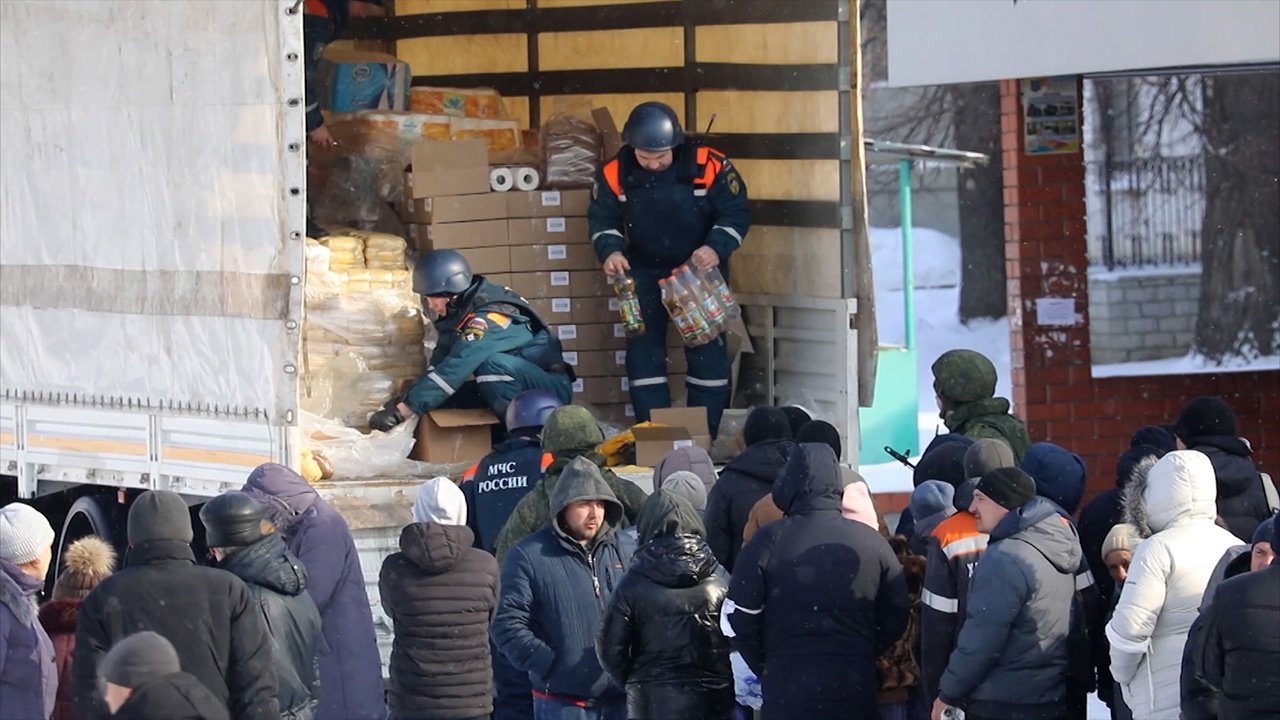Locust infestation in Balochistan & Sindh this year is one of the worst outbursts in decades. Pakistan Government has not helped farmers in Balochistan or Sindh. Lack of empathy for Balochistan and Sindh is seen in Punjabi Pakistan. Pakistan Prime Minister Imran Khan is busy trolling their neighbor India on different issues that are Internal to India rather than working for the preventing the further spread of Locust Infestation outside Balochistan and Sindh.
Earlier in April 2019, Iran faced the worst locust attack in 40 years. Iran’s southern provinces faced unprecedented swarms of desert locusts invading an area of 200 thousand hectares over six provinces. According to the President of the Plant Protection Organization of Iran (PPO), over 200 swarms of locusts reached Iran from Saudi Arabia to date. Every swarm can contain between 30-100 million locusts. Every 50 million locusts can eat the food of 25000 people in a short time and endanger Iran’s food security. An Iranian MP accused Saudi Arabia and said that this may be a deliberate attack such as bioterrorism, but it needs further investigation. Ali Akbari stated that creating an economic crisis is a significant strategy for exerting pressure on Iran. People have negated this theory of Bio Terrorism since locust attack is a natural phenomenon and many countries are impacted. Iran also faced floods, earthquakes, sand storms and more natural issues during 2019.
The UN Food and Agriculture Organization (FAO) said in February that a locust outbreak in Sudan and Eritrea was spreading rapidly along both sides of the Red Sea to Saudi Arabia and Egypt.
The FAO also noted that good rains have allowed generations of locust breeding since October 2018, leading to a substantial increase in locust populations and the formation of highly mobile swarms.
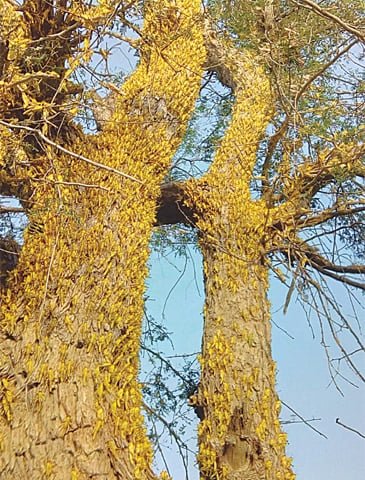
Adult locust swarms can fly up to 150 km a day with the wind and adult insects can consume roughly their own weight in fresh food per day.
A very small swarm eats as much in one day as about 35,000 people, posing a devastating threat to crops and food security.
The desert locust is potentially the most dangerous of the locust pests because of the ability of swarms to fly rapidly across great distances.

Plagues of desert locusts have threatened agricultural production in Africa, the Middle East, and Asia for centuries. The livelihood of at least one-tenth of the world’s human population can be affected by this voracious insect.
Desert locust is a small winged insect that inhibits the ability to destroy crop fields during their migration or breeding seasons when they fly in hordes. A single locusts’ swarm ranges from 100,000 to 1 billion locusts flying from one place to another over land.
Locust Infestation in Balochistan
These locusts in Pakistan have two breeding times and regions: The summer (monsoon June – Nov) breeding period zone in Sindh and Southern Punjab’s deserts of Tharparkar, Khipro and Cholistan and the spring (winter Feb – June) breeding period zone in the desert areas of Balochistan such as Pasni, Turbat, Panjgur, Kharan and Nushki. [Food and agriculture organization of the United Nations FAO-UN]
Pakistan has experienced locusts’ attacks in their breeding regions and outskirts in the past but this year one of the worst outbursts were observed. Attacks were reported throughout the year such as in May and June 2019, and then again in November of the same year with variable amount of damage in different crop regions. The south west Pakistan i.e. areas of Balochistan were severely affected as swarms ravaged wheat, cotton and vegetable crops.
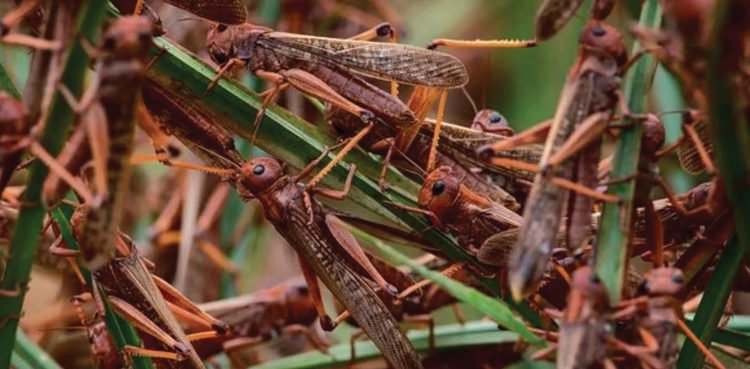
These outbreaks happen in Pakistan when there is a surge in locust population in neighboring countries that are the potential habitat of the species. The recent attacks started somewhere in the Middle East; Yemen to Saudi Arabia and Oman and then towards Iran. From Iran a huge population of these locusts invaded regions of Balochistan in Chaghi and Pasni from where they moved to Sindh and returned back to the coastal areas of Balochistan last month to find new breeding grounds.
As per the reports parts of lower Punjab are also now impacted with the Locust Invasion.
In July 2019, according to media reports, crop fields in Nushki, Khuzdar, Washuk, Awaraan and Lasbela were hugely spoiled by the swarms and an economic loss of Rs 40 to 50 crores was estimated. It is noteworthy to mention here that these areas are already Malnutrition struck and farmers here are often in debt.
The control teams of the Department of Plant Protection had been defunct and didn’t do anything to help the farmers in Balochistan. National Assembly posts figures and data that they will release funds to help the farmers. But nothing reached any single farmer in Balochistan. In November, the National Assembly Standing Committee on National Food Security has briefed that over Rs 500 million has been allocated to minimize the attack of desert locust and 100,000 tonnes of pesticide would be imported for their control. However our sources tell that this money will go in the pockets of a few and these Pesticides will never be used to help farmers in Balochistan or Sindh and will be used only to help the Punjabi farmers and landlords in Punjab. People are well aware of the step-motherly treatment meted out to farmers in Balochistan, Sindh.
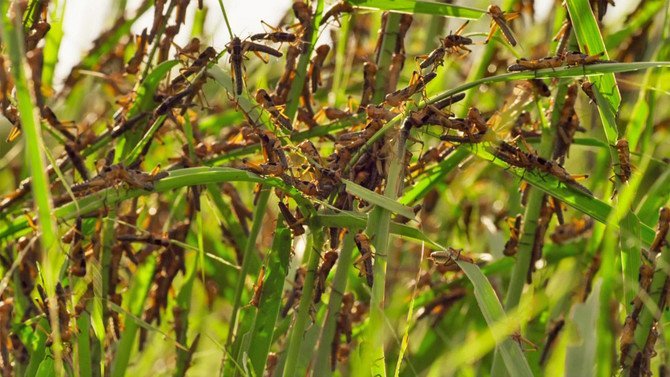
Currently, millions of these locusts’ grounds are present in Pakistan requiring a timely action from the concerned departments as the threat to agriculture land in Balochistan and Sindh regions of Pakistan is huge as reported by the FAO-UN.
An official from the plant protection department reports that only 2 out of 21 crop spraying planes are functional that will of course not be enough to control the locust’s grounds. Hence, a speedy analysis of the loopholes in control strategy must be made to timely control the imposed threat. The recent actions on behalf of the ministries are upright but the velocity and planning seem to be somewhat sluggish. Moreover the data on area covered by insecticide spraying is manipulated to give a good picture of Pakistan that they are concerned about the issue. However in reality as per farmers in Balochistan no government official has visited them to even see their Locust infested farms. Baloch farmers are requesting the International organizations to visit Balochistan and themselves see that the data presented by Pakistan is totally fake.
Reasons for the Negative growth in Agriculture in Pakistan is the poor governance of concerned ministries especially at Federal level, expensive inputs, locust attack, poor coordination among provinces & poor production of cotton, sugarcane, wheat & vegetables. It should be noted that most of the time spent by Imran Khan Government was focusing on Indian Kashmir and getting the title of Prime Troller who trolls its neighbor India on every internal matter of India. However, irony is that India is a rich and prosperous country whereas people in Pakistan do not have roti or Naan to eat. Everything is too expensive that as per people there will be food riots in Pakistan in near future.
One Balochistan farmer told that they have no food and no money to feed their families. The cost of fertilizers, insecticides is too high. The cost of diesel/electricity is also very high. The loans are available at exorbitant rate of Interests. They cannot even pay the earlier loans they had taken for the previous crops that were destroyed by the Locust Infestation. In some cases the Interest accumulated is more than the principle amount. They cannot see their children die. Instead they will pick up guns and will throw out this tyrannical government which is using its Army to exploit all the natural resources from Balochistan while doing nothing to help the poor farmers and their families.
Demand for Azad Balochistan has grown stronger. In the coming months there will be stepped up violence. Reasons partly will be shortage of food and partly the Genocide and enforced disappearance of local Baloch by Pakistan Army and then either killing them or selling them for organ harvesting. The Anger is brewing and will very soon likely to explode that Pakistan Government will not be able to control.
Government Apathy coupled with Nature’s onslaught in Sindh
In our previous article we had shown the apathy and step motherly treatment when it comes to the issues plaguing Sindh and especially Karachi. Sindh is the biggest contributor to Pakistan GDP and what did it get in return? Previously there was rain and sewage water flooding the streets. 31 persons died due to electrocution. K-Electric that is the only electricity company in Karachi that is being sold to Chinese had raised Electricity prices. We covered it in our previous article Corrupt Imran Khan Arrogant K-Electric Electrocuted 37 People In Karachi, Sindh
Thereafter there was fly infestation in Karachi. We covered it in details in our previous article Flies Infestation In Karachi – Waiting To Beg Money From Donors In The Event Of Epidemic?
Thereafter Fauji Foundation lead Fertilizer companies cartel increased the Fertilizer prices up to 25%. Besides that impact of climate change and locust attack played havoc on Sindh. These factors are set to turn the economists’ little doubt into a major worry.
Sindh Abadgar Board (SAB) Senior Vice President Mahmood Nawaz Shah said, “A study suggests that the agriculture sector performance has continued to decline for the past 19 years. The sector is feared to continue the downward trend in the 20th straight year – FY20.”
The share of agriculture sector – crops and livestock – in the gross domestic product (GDP) was around 21-22% in recent years. “It (agriculture sector) may hardly retain a share of 18-19% in GDP this year (FY20),” said Agri Forum Pakistan Chairman Ibrahim Mughal.
Acute shortage of water did not let the agriculture sector perform well last year – FY19. This year, the availability of water was not an issue but a “massive increase in fertiliser (urea and DAP) prices by up to 25% has badly hit agricultural (crops) output as high prices discouraged farmers from using a good quantity of fertiliser.”
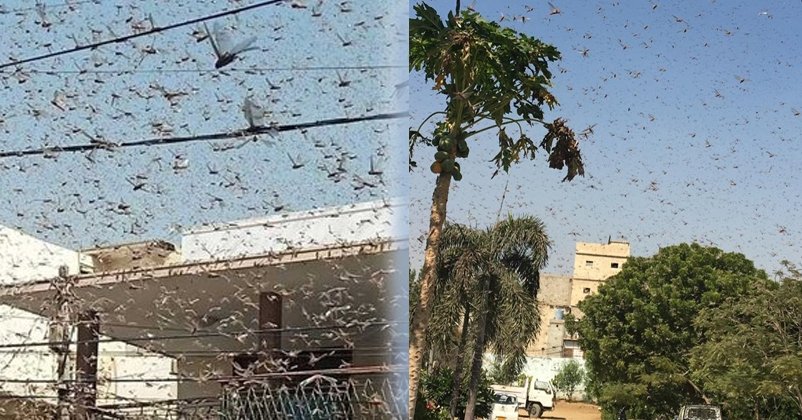
He shifted his government failure at the center to the local provincial governments and held them responsible for the continued poor performance of the agriculture sector since farming had become a provincial subject under the 18th Constitution Amendment in 2010.
“No agriculture policy, no planning and a lack of will at the provincial levels were behind the pathetic performance. Provincial authorities have given the agriculture sector in the hands of inexperienced people,” Mughal said.
Climate change had already badly hurt two major summer crops – cotton and paddy. Temperature was extensively high, especially in northern Sindh districts of Dadu, Larkana, Qambar Shahdadkot, Shikarpur and Sukkur. “This has damaged 20-25% of paddy crop in such areas.”

Secondly, the torrential rains just before the first round of cotton picking hit the standing crop in fields in September.
Farmers used to make three to five cotton picking in one season. However, the rains in the range of 11 to 15 inches in a 40 to 45-day period in some districts damaged a significant portion of the crop. Besides, high temperature in the cotton-growing areas in Punjab also did not let farmers harvest a good crop. “The situation did not allow achievement of the cotton output target for the season
The year 2019 also has seen tomato and onion crisis as well. Their prices hit historic highs of Rs400 per kg and Rs100 per kg in retail, respectively, in the year. “Rains have affected about 30-40% of the early crop of onion and damaged the entire crop of tomato, which is a very sensitive food crop.”
Locust attack in Sindh
Apart from these, the arrival of locusts in Sindh and a few adjoining areas in lower Punjab has sparked fears among the farmers.
“Locust attack has damaged the chilli crop, has added to the miseries of cotton growers and has the potential to impact the wheat crop, which is in the last stages of sowing these days,” he said. Citing anecdotal evidence, he believes the locust attack may not badly impact the wheat crop on a wide scale. “However, whenever and wherever they attack, they completely destroy the crop. I know the farmers who planted wheat three times this season, but the locust attack devastated the crop on all occasions.”
For instance, if the locust attack damages 2% of the area cultivated with the wheat crop, it may appear small on the macro scale, but it will be huge for the farmers who suffer. Farmers have planted the crop over 2-2.2 million hectares of land in Sindh.
“If the wheat crop fails to find favorable weather, the locust attack may hit its production over a wide area like it did in the case of cotton.”
Both the federal and provincial governments have done virtually nothing to stave off the threat from the insect.

“There is no damage assessment after the locust attack. However, when you will pass through Mirpur Khas district, you will find locusts both at your right and left …and in Nawabshah and Sukkur towards border areas (with India).”
“In a nutshell, I don’t see any improvement in the agriculture production this year too, but a further decline. Poor output of cotton and maize will contribute substantially to the overall decline.” Economist Dr Ashfaque Hasan Khan said months ago if the agriculture sector failed to perform this year too, the GDP growth may slip below 3%.
Economist Dr Hafiz Pasha said if the sector continued to underperform, it would be hard for the country to achieve GDP growth of 2.4% anticipated by the International Monetary Fund (IMF) for FY20.

Some Economists have predicted the GDP to go even negative.
Pakistan Government that hates Balochistan and Sindh and exploits it to the maximum to the benefit of Punjabis in Punjab and feed the ever rich Fauji Foundation and its ever increasing demands did nothing to control the Locust infestation.
A source on condition of anonymity told, “Government wants to drive Sindhis and Mohajirs to poverty so that they do not have any resources left for raising their voice for freedom of Sindhu Mahadesh. He also said that Government planned to do nothing to stop the Locust invasion except the lip service because they believed that with the wind flowing in the direction of India, these Locust will also destroy crops of their enemy (India). Hence the government did nothing and let the Locust population multiply at the cost of poor people in Sindh.”
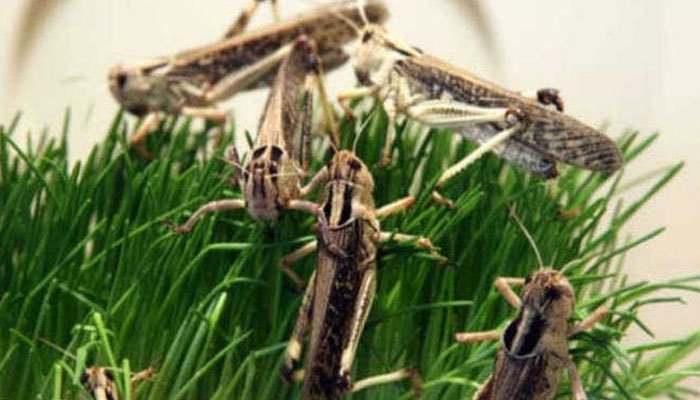
He also told that, “as soon as the current food stocks starts to decrease, the prices of Roti and Naan will also increase. Poor people will have no food and soon the frustration will be seen on the streets in the form of armed riots and looting of Grocery stores and warehouses. People are now realizing that as long as they remain in Pakistan, they will be exploited. Moreover, Mohajirs still do not have any reservations in any Government jobs even after 72 years of Partition with India. Support for Altaf Hussain is every increasing.”

He also told about the gimmicks of Pakistan Army and Intelligence Agency ISI to float a new party in the name of MQM headed by a former Karachi Mayor will also fail.
Another person told, “Pakistan had wished that Balochistan and Sindh will come to their knees and beg the Punjabis for food. However now Punjab province will also be impacted by Locust invasion. We will not beg Pakistan for food. We in Karachi have fed this giant Pakistan Army for last 72 years. Whole Pakistan Army runs on our money. We will show this government that enough is enough. We will stop paying taxes. We will take back what is right fully ours. You will see 2020 as the year of Mohajirs and Sindhis. Together we will take back what belongs to us. We will get our Azadi.”
Points to Ponder
Will this Do Nothing Imran Khan Government ever wake up? Do they think Baloch, Sindhis, Mohajirs are not human beings? Do they think that the whole world will just watch when millions of people in Balochistan and Sindh are left to starve as a punishment due to their ethnic difference? Does Pakistan thinks that Punjabis are superior and invincible? Will Locust Invasion not reach Punjab province in Pakistan? Will its neighbor India not help Balochistan and Sindhu Mahadesh to get Freedom from tyranny of Pakistan? Has its policy of bleeding India with thousand cuts done any good to Pakistan? What happens if neighboring India retaliates to take back its lands from Pakistan? Do they have funds to defend and continue their occupation in Pakistan occupied Kashmir and Gilgit Baltistan? Should Pakistan not just handover Indian Territories to India and work on the betterment of its existing territories? Or does Pakistan Plans to lose Balochistan and Sindhu Mahadesh also? Year 2020 will bring more clarity on how future unfolds for a failed Pakistan that is a forte of Terrorists.
Follow us at:-
Twitter Handle: @communique_news
Parler Handle: @newscommuniquecom
Subscribe our : YouTube Channel https://www.youtube.com/channel/UCnKJQ3gFsRVWpvdjnntQoAA
Like our Facebook Page https://m.facebook.com/News-Communiquecom-103788531007438/
1,242 total views






